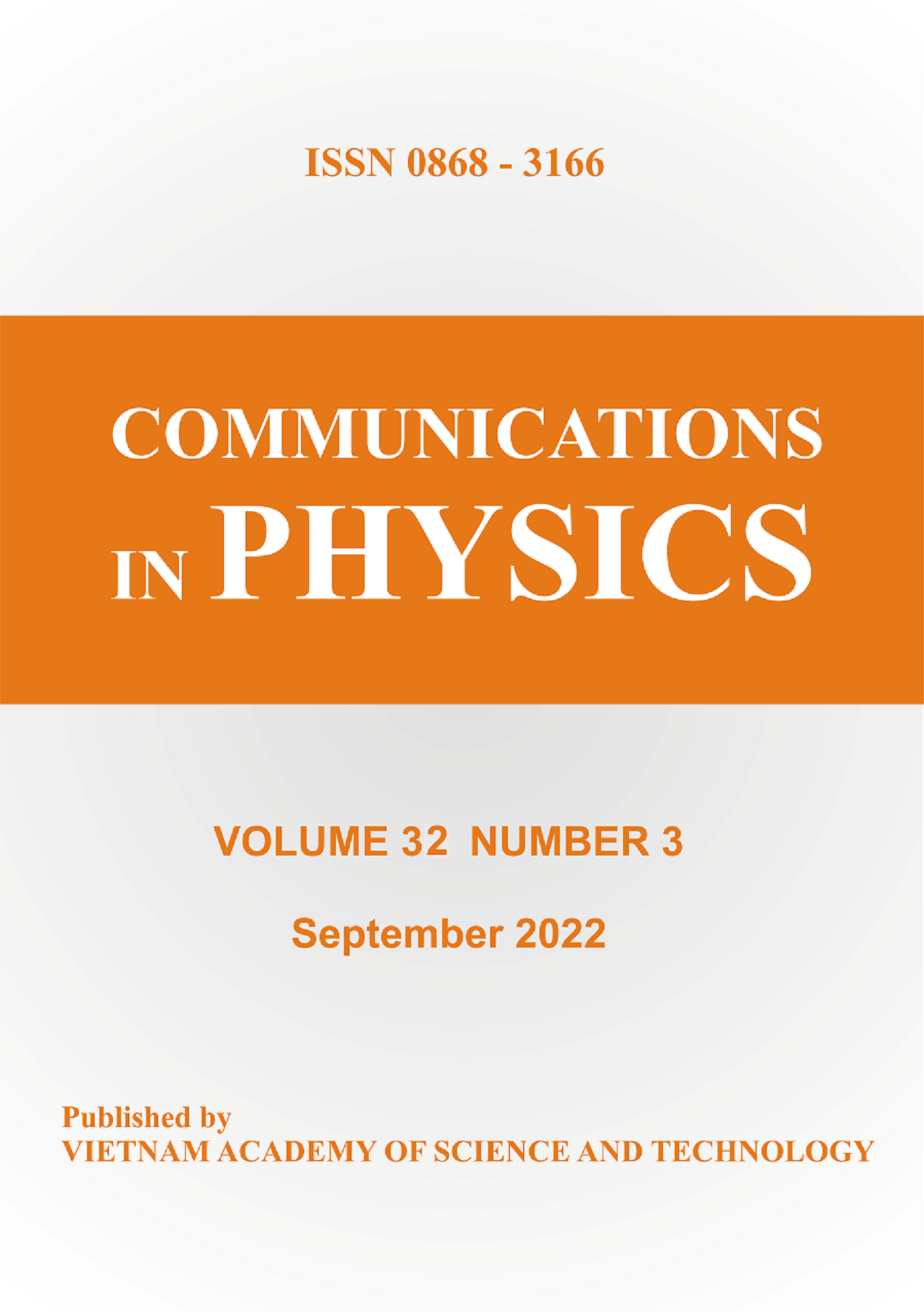Tuning Electronic Transport Properties of Zigzag Graphene Nanoribbons with Stone-Wales Defect
Author affiliations
DOI:
https://doi.org/10.15625/0868-3166/28/3/12670Keywords:
density-functional theory, non-equilibrium, Green function, electronic transport, graphene nanoribbon, transmission spectrum, current\textendash voltage characteristicsAbstract
Influences of the symmetric Stone-Wales (SW) defect on the electronic transport properties of the zigzag graphene nanoribbons (ZGNRs) has been studied using $\it{ab}$ $\it{ initio}$ simulation based on density functional theory (DFT) combined with non-equilibrium Green's function (NEGF) technique. The calculated transmission spectra T(E) at various bias windows, device densities of states (DDOS), current characteristics as well as local density of states (LDOS) of the defective asymmetric and symmetric ZGNRs are presented in comparison of those for the pristine ZGNRs. It has been established the metallic character of the electronic transport in asymmetric ZGNRs, and in symmetric ones, the current has a semiconductor behavior, with negative differential resistance (NDR) effect. Symmetric SW defect, as a most unfavorable SW defect type for electric conductance, remarkably decreases the current values, but does not change the character of conductivity in both the asymmetric and symmetric ZGNRs. NDR has been explained by the altering by SW defect the number of frontier molecular orbitals entering bias windows.Downloads
Metrics
References
K. S. Novoselov, A.K.Geim, S. V. Morozov, D. Jiang, Y. Zhang, S. V. Dubonos, I.V.Grigorieva and A. A. Firsov,
![]()
Science 306 (2004) 666.
DOI: https://doi.org/10.1126/science.1102896
![]()
K. S. Novoselov, A.K.Geim, S.V.Morozov, D.Jiang, M.I.Katsnelson, I. V. Grigorieva, S. V. Dubonos and A. A.
![]()
Firsov, Nature 438 (2005) 197.
DOI: https://doi.org/10.1038/nature04233
![]()
J. P. Llinas, A. Fairbrother, G. B. Barin, W. Shi, K. Lee, S. Wu, B. Y. Choi, R. Braganza, J. Lear, N. Kau,
![]()
W. Choi, C. Chen, Z. Pedramrazi, T. Dumslaff, A. Narita, X. Feng, K. M¨ullen, F. Fischer, A. Zettl, P. Ruffieux,
![]()
E. Yablonovitch, M. Crommie, R. Fasel and J. Bokor, Nature Communications 8 (2017) 633.
DOI: https://doi.org/10.1038/s41467-017-01658-2
![]()
M. Choudhury, Y. Yoon, J. Guo and K. Mohanram, Proceedings of the 45th annual Design Automation Conference
![]()
F. Banhart, J. Kotakoski and A. V. Krasheninnikov, Acs Nano 5 (2011) 26.
DOI: https://doi.org/10.1021/nn102598m
![]()
J. Lahiri, Y. Lin, P. Bozkurt, I. I. Oleynik and M. Batzill, Nature Nanotechnology 5 (2010) 326.
DOI: https://doi.org/10.1038/nnano.2010.53
![]()
G. D. Lee, C. Z. Wang, E. Yoon, N. M. Hwang, D. Y. Kim and K. M. Ho, Physical Review Letters 95 (2005)
DOI: https://doi.org/10.1103/PhysRevLett.95.205501
![]()
L. Li, S. Reich and J. Robertson, Physical Review B 72 (2005) 184109.
DOI: https://doi.org/10.1103/PhysRevB.72.184109
![]()
Z. Li, B. Huang and W. Duan, Nanoscience and Nanotechnology 10 (2010) 5374.
DOI: https://doi.org/10.1166/jnn.2010.1955
![]()
X. Li, D. Zou, B. Cui, C. Fang, J. Zhao, D. Li and D. Liu, The Royal Society of Chemistry 2017 7 (2017) 25244.
DOI: https://doi.org/10.1039/C7RA02624B
![]()
K. Li and X. H. Zhang, Physics Letters A 382 (2018) 1167.
DOI: https://doi.org/10.1016/j.physleta.2018.02.033
![]()
W. L. F. H. Meng, J. H. Zhao and X. H. Jiang, Theoretical and Computational Chemistry 16 (2017) 1750032.
DOI: https://doi.org/10.1142/S0219633617500328
![]()
Y. Ren and K. Q. Chene, Phys. Rev. Lett. 107 (2010) 044514.
DOI: https://doi.org/10.1063/1.3309775
![]()
J. P. Perdew, K. Burke and M. Ernzerhof, Phys. Rev. Lett. 77 (1996) 3865.
DOI: https://doi.org/10.1103/PhysRevLett.77.3865
![]()
H. J. Monkhorst and J. D. Pack, Phys. Rev. B 13 (1976) 5188.
DOI: https://doi.org/10.1103/PhysRevB.13.5188
![]()
S. Grimme, J. Comput. Chem. 27 (2006) 1787.
DOI: https://doi.org/10.1002/jcc.20495
![]()
R. Landauer, IBM J. Res. Dev. 1 (1957) 223.
DOI: https://doi.org/10.1147/rd.13.0223
![]()
J. Ma, D. Alf`e, A. Michaelides and E. Wang, Physical Review B 80 (2009) 033407.
DOI: https://doi.org/10.1103/PhysRevB.80.033407
![]()
R. Dettori, E. Cadelano and L. Colombo, Physics: Condensed Matter 24 (2012) 104020.
DOI: https://doi.org/10.1088/0953-8984/24/10/104020
![]()
H. Zeng, J. P. Leburton, Y. Xu and J. Wei, Nanoscale Research Letters 6 (2011) 254.
DOI: https://doi.org/10.1186/1556-276X-6-254
![]()
Y. Zou, M. Long, M. Li, X. Zhang, Q. Zhang and H. Xu, The Royal Society of Chemistry 5 (2015) 19152.
DOI: https://doi.org/10.1039/C4RA12924E
![]()
Downloads
Published
How to Cite
Issue
Section
License
Authors who publish with CIP agree with the following terms:- The manuscript is not under consideration for publication elsewhere. When a manuscript is accepted for publication, the author agrees to automatic transfer of the copyright to the editorial office.
- The manuscript should not be published elsewhere in any language without the consent of the copyright holders. Authors have the right to enter into separate, additional contractual arrangements for the non-exclusive distribution of the journal’s published version of their work (e.g., post it to an institutional repository or publish it in a book), with an acknowledgement of its initial publication in this journal.
- Authors are encouraged to post their work online (e.g., in institutional repositories or on their websites) prior to or during the submission process, as it can lead to productive exchanges or/and greater number of citation to the to-be-published work (See The Effect of Open Access).
Accepted 14-08-2018
Published 14-11-2018













